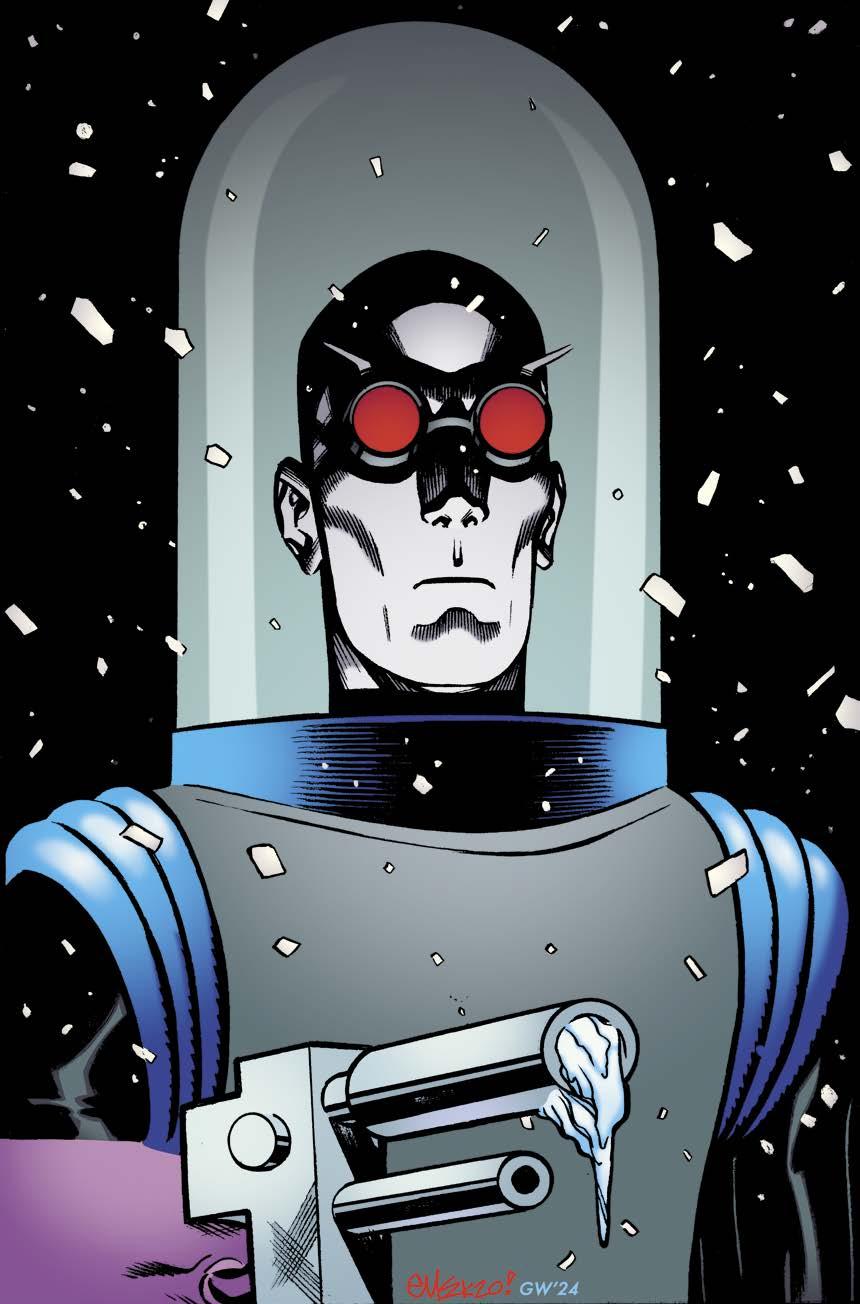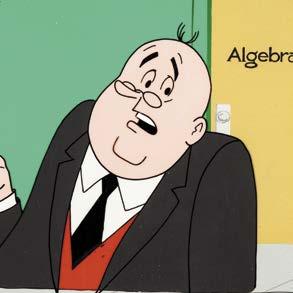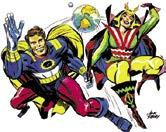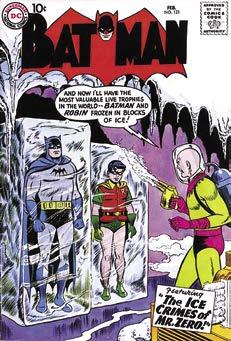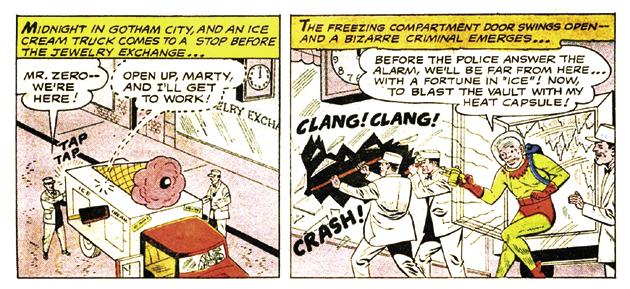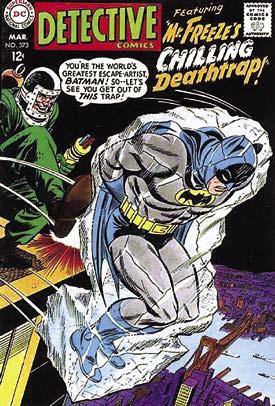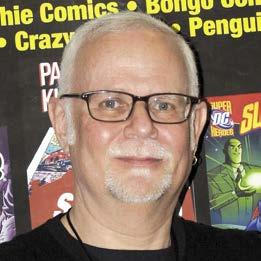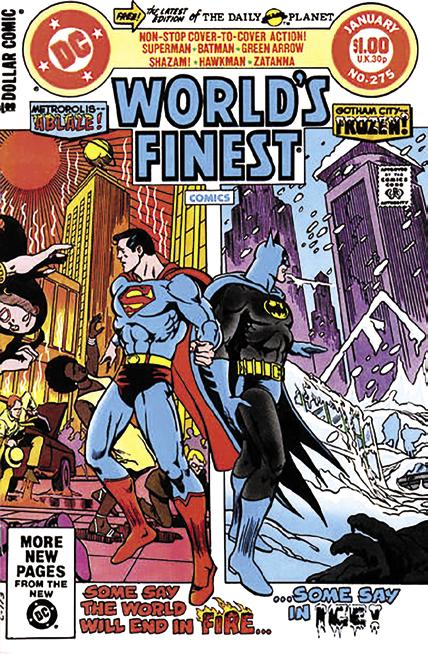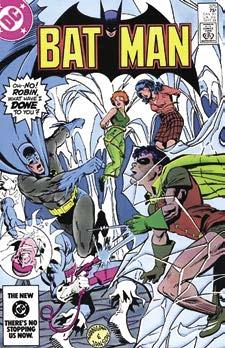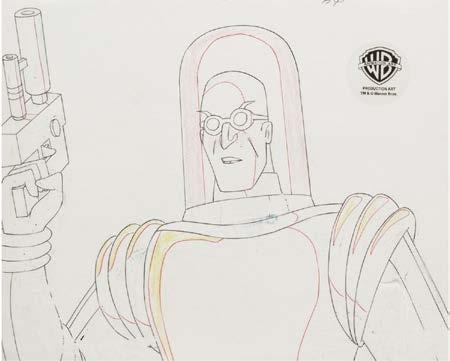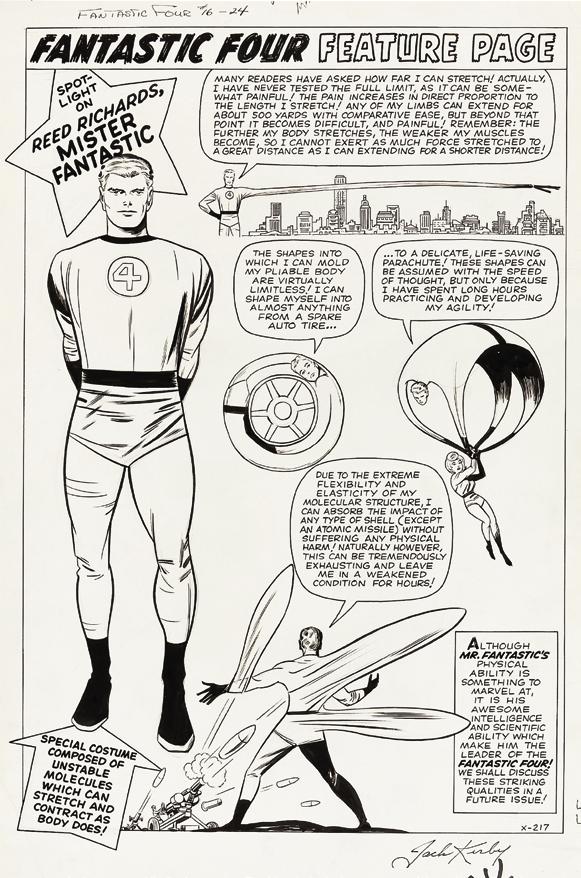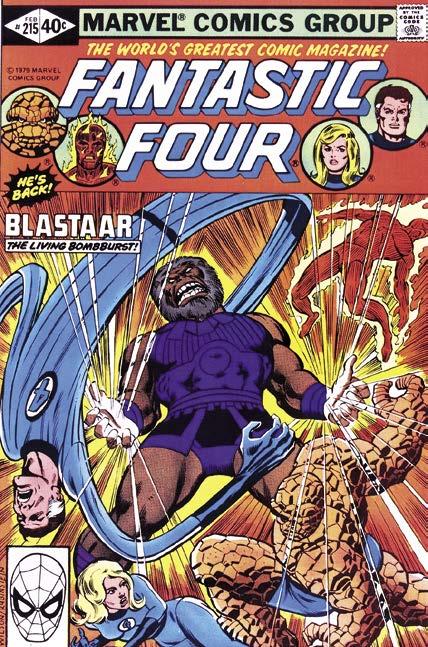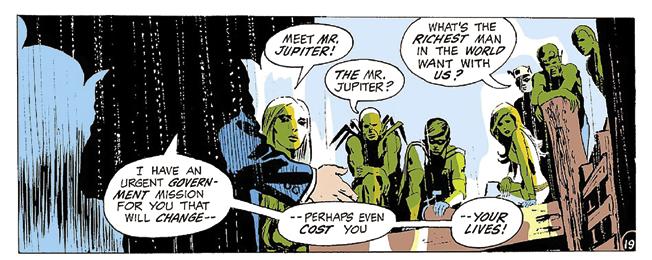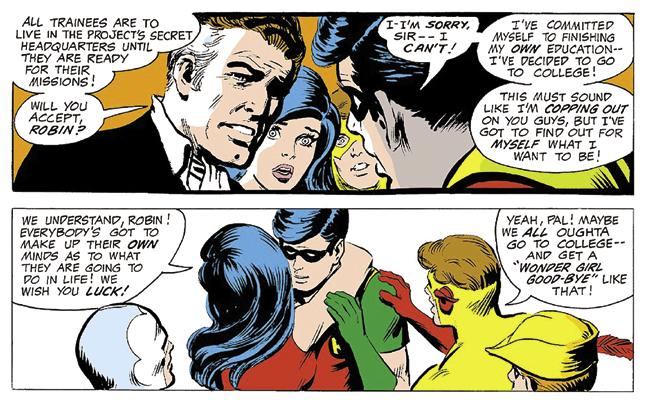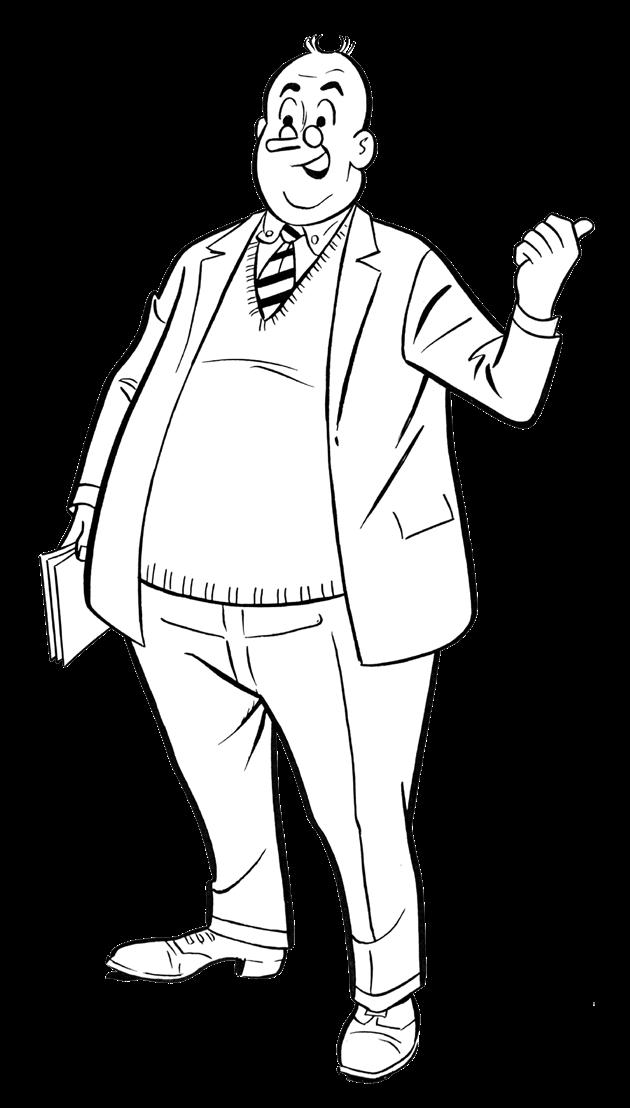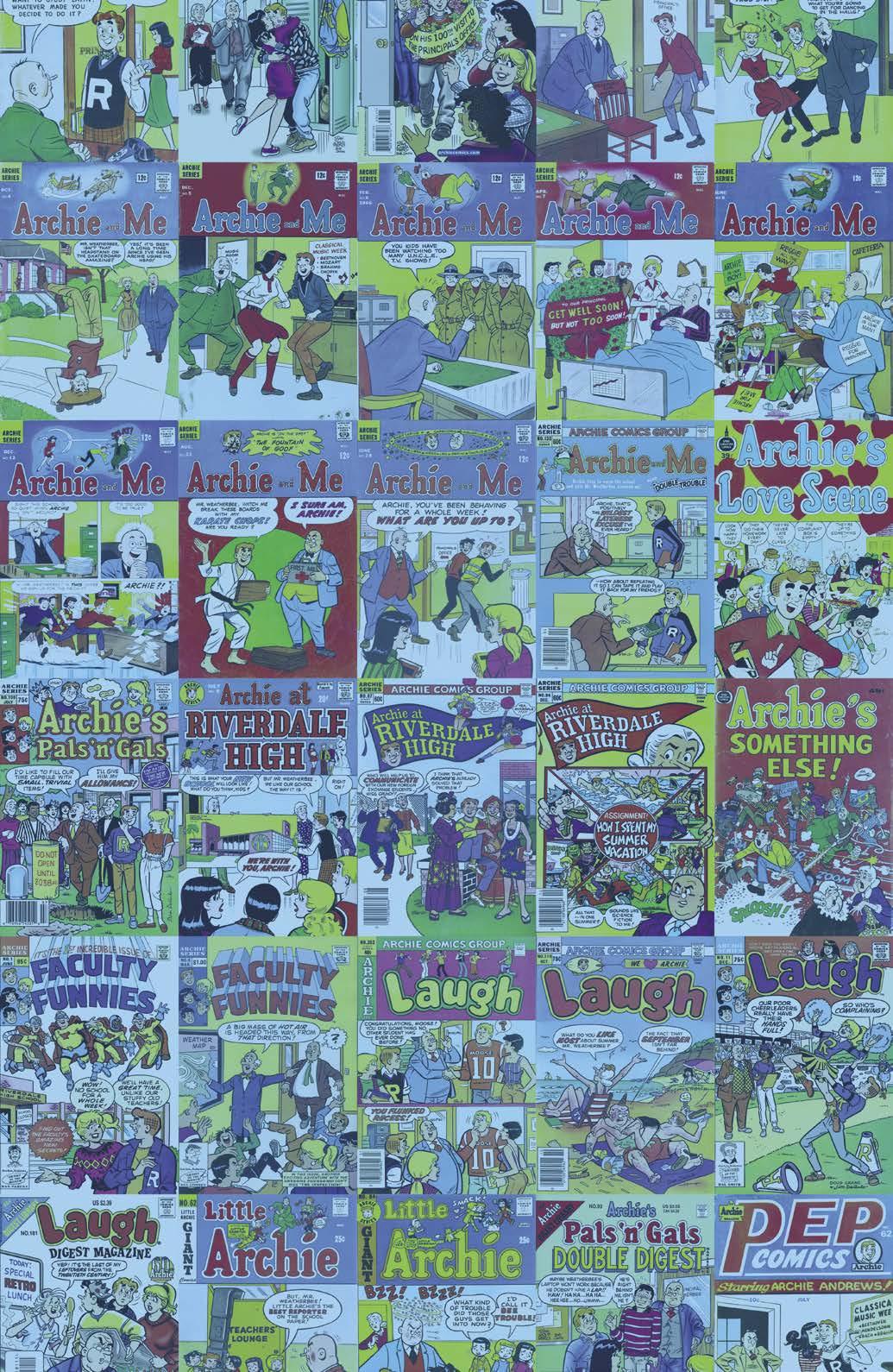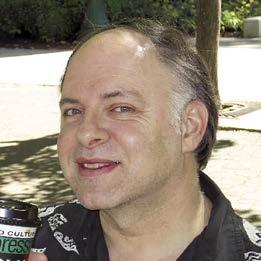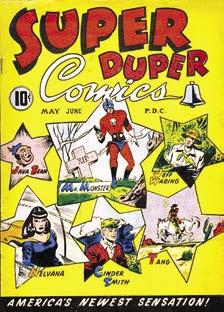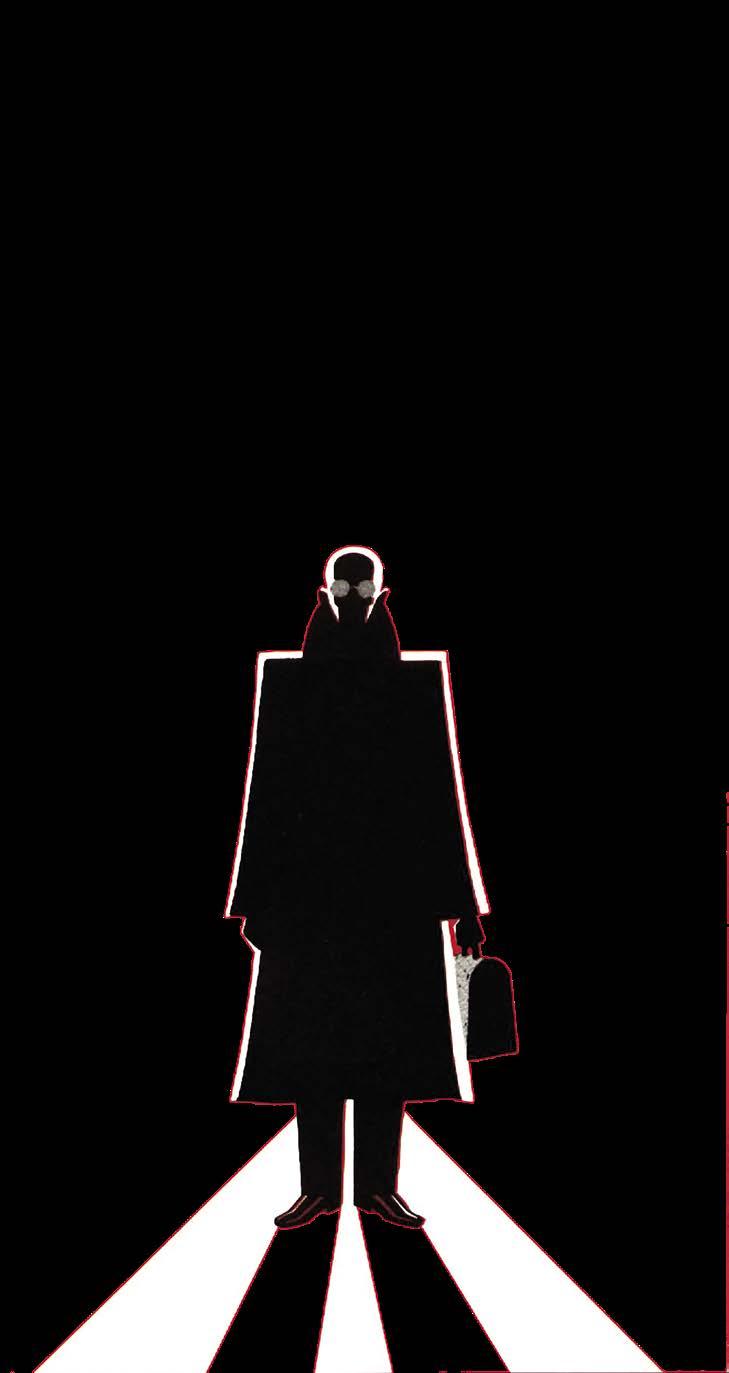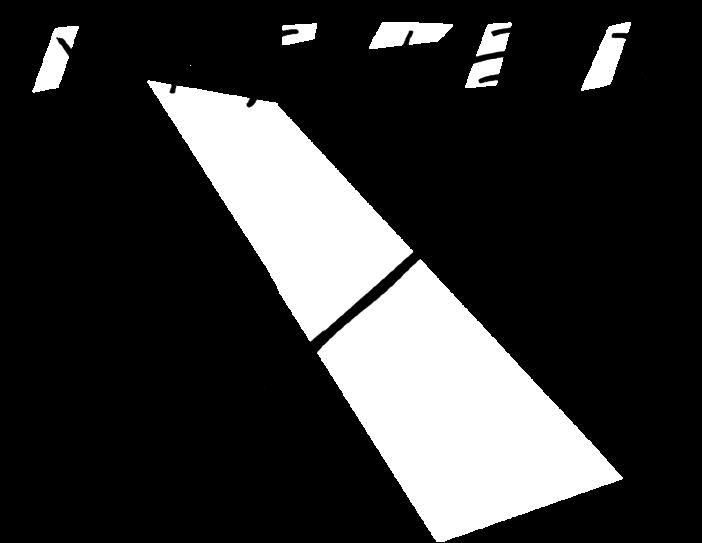Ice water in his veins: The life and crimes of
Perhaps unique to this issue’s theme, the character profiled here was a Mr. not once, but twice. The first time the frozen felon appeared was in the pages of Batman #121 (February 1959) in the Dave Wood scripted “The Ice Crimes of Mr. Zero.” Additional credits include a cover by Curt Swan with Stan Kaye inks and Ira Schnapp lettering. Interiors were done by Sheldon Moldoff with Charles Paris inks and all under the editorial supervision of Whitney Ellsworth.
by Bryan D. Stroud
Cold themed criminals were nothing new at the time. There were a number of them in the Golden and Silver Ages of National/DC Comics, almost inevitably armed with some sort of ice-emitting weapon. Included in that roster are the Blue Snowman from Sensation Comics #59 (1946), the Icicle in All-American Comics #90 (October 1947), Minister Blizzard in Wonder Woman #29 (1948), Captain Cold from Showcase #8 (June 1957), and, interestingly enough, a story from Blackhawk #117 (October 1957) featuring “The Fantastic Mr. Freeze,” who turned out to be a robot wielding an instant freezing ice machine.
Our first glimpse of Mr. Zero inside the issue is of a bald man in a smoking jacket who doesn’t appear all that menacing, but he has entombed the Dynamic Duo of Batman and Robin in blocks of solid ice and his headquarters appears to be something along the lines of a deep freeze.
As the story unfolds, Zero is seen in action wearing a reasonable facsimile of a space suit with a bubble helmet and an apparatus strapped to his back. He and his gang are robbing a jewelry exchange, and he uses a one-two punch of a modified blowtorch followed by ice gas to cause the vault to crack, allowing them to steal all the “ice” they can manage. Despite the arrival of Batman and Robin, Zero’s use of his device to turn the street into a skating rink allows him to escape justice.
A little later in the story, the villain recounts his origin to a new recruit. He explains he was the victim of an accident while experimenting with his newly invented ice gun. The container holding his freezing solution burst and saturated him, resulting in his being unable to breathe at normal temperatures. “Thus was Mr. Zero born! I perfected an air-conditioned costume to help me commit my crimes… and built this hidden, refrigerated mountain lair!”
THE COMING OF MR. FREEZE
The ominous Mr. Freeze dominates the art from the cover of The New 52’s Batman Annual #1 (2012). (inset) Our first look at Mr. Zero on the cover of Batman #121 TM & © DC Comics.
More ice and cold gimmicks are deployed throughout the story until the final showdown when Mr. Zero is exposed to steam from a broken pipe that appears to have restored him to normal. Based on the sequence of events, it would appear that Mr. Zero was yet another in a long line of throwaway villains for Batman and Robin to tackle. He wasn’t even given an alter ego in this debut tale, but the chilly chilblain would return to vex Batman. First, however, he would undergo a slight transformation on the small
“Hey, Mister!” Issue • BACK ISSUE • 3
screen when he became Mr. Freeze on the Batman television series in 1966. Freeze would appear three times, portrayed by three different actors and with the ensuing Batmania that followed the popularity of the series, Mr. Zero was back with a new name and a somewhat modified outfit, this time resembling a stouter diving suit.
“Mr. Freeze’s Chilling Deathtrap!” was printed in Detective Comics #373 (March 1968) and was written by Gardner Fox with interiors produced by Chic Stone and Sid Greene under an Irv Novick cover. The splash page fills the reader in as to whom we’re dealing with: “It’s chill-thrill time again as the refrigerated rogue— Mr. Zero—blasts out of his deep-freeze hide-out to taunt Batman and Robin with his tricky temperature tactics! Bolder and colder than ever—and with a new name to match—he zeroes in his prey and the frigid fate he has finalized for them!”
As if that intro wasn’t enough to tip readers to the influence of the TV show, a line uttered by Robin later in the story left no doubt: “Mr. Freeze! That sounds like a campy name dreamed up for a villain in a television program!”
Ultimately, a new name and suit, along with a Cryothermal gun added to his arsenal, did not help the frozen fiend prevail over the World’s Greatest Detective, and Mr. Freeze went into cold storage following this second and final appearance in the Silver Age.
A little over a decade later, Mr. Freeze returned in Batman #308 (February 1979) in a Len Wein story titled “There’ll be a Cold Time in the Old Town Tonight.” After another uniform makeover, Freeze looks vaguely like Captain Cold minus the parka hood and his cold gun resembles Captain Cold’s sidearm, too, unlike the spray assembly he’d been wielding before. Another change is his seeming shift from simple thief to entrepreneur, trading “immortality” in a cryogenic deep freeze to a millionaire in return for part of his fortune. Unfortunately, the process has created an ice zombie instead, and he is once again defeated by Batman.
A few years later, Freeze showed up to bedevil both Batman and Superman in the pages of World’s Finest Comics #275 (January 1982), but it bears noting that just a month prior based on sale dates, writer Alan Brennert gave a nod to Mr. Zero in The Brave and the Bold #182 (January 1982) as the Earth 2 Robin uses Mr. Zero’s freeze gun from the artifacts in the Batcave to foil a Batman robot controlled by Professor Hugo Strange.
(top row) An ice cream truck is the perfect transportation for a cold villain. (2nd row left) Mr. Zero becomes Mr. Freeze on the cover of Detective Comics #373. (2nd row right) Eli Wallach as Mr. Freeze from the Batman TV series. Courtesy of Heritage Auctions (www.ha.com). (3rd row)
The dialog in Detective Comics #373 shows the influence of the TV show as the Dynamic Duo take on Mr. Freeze. (bottom left) Mr. Freeze, Fashionista? His costume changes yet again in Batman #308. (bottom right) Robin pulls a familiar weapon from cold storage in The Brave and the Bold #182. TM & ©
Comics.
A CHAT WITH MR. KUPPERBERG
Back now to World’s Finest and the Paul Kupperberg story “Summer Nights Winter Days!” Illustrated by Rich Buckler and Frank McLaughlin with Len Wein serving as editor, it’s June and Metropolis is suffering a heat wave while Gotham City “…not a dozen miles…” from Metropolis is in a deep freeze. It seems Mr. Freeze is busily creating an arctic habitat for himself by turning Gotham City into his private winter wonderland. Freeze has discovered a way to siphon off the heat byproducts to Metropolis and therefore involves both heroes. To no one’s surprise, the criminal is once again “put on ice,” and things are restored to normal in both locations.
BACK ISSUE : Do you recall any plotting sessions with Len?
Scripter Paul Kupperberg graciously shared his recollections of this story with BACK ISSUE in a short Q&A.
BACK ISSUE: Do you remember how the assignment came about?
PAUL KUPPERBERG: Not really. In those days, I was one of those guys who was always around the office and when somebody needed a fill-in or a story in a hurry, they’d maybe see me walking down the hall and go, “Get in here!” Literally, I picked up half my assignments that way in those days. I remember it was a cool story. Rich Buckler drew it and Frank McLaughlin inked it.
BACK ISSUE: Did you have to do any research into the character prior to scripting?
KUPPERBERG: I was pretty well up to date with all the characters in the DC Universe in those days. Because again, I might be called upon at any moment to write any character. They might need a fill-in on dialogue for some book or an emergency fill-in story. Whatever it is, if I’m walking down the hall and called into an editor’s office, it was important to be ready.
I did remember that first Batman appearance of Mr. Zero, and then in the 1966 Batman series… I think back then he was a C list Batman villain, and I don’t think anybody bothered to give him much thought or personality. Kind of one-dimensional. I think there were references to an origin, but I can’t even think of it.
KUPPERBERG: We must have, even if it was just “You got any ideas?” This is total guesswork, but I’m thinking Len must have thrown out Mr. Freeze as the villain, because I don’t think he’d have been the kind of character that would be on my radar. Then, once we’d established it would be Freeze, I began to think of what would work well and decided to pit ice against fire. Back in those days, thanks to the Atlas of the DC Universe, we knew that Gotham City and Metropolis were across the bay from each other, so it was easy to link up Superman and Batman. It was one of the few times I got to write Batman. I had dialogued some issues of Detective or Batman for Gerry Conway, but I don’t think I ever wrote Batman on his own and I think that was the only time, in that story.
It was a good enough story for the time, but it was another in a long list of assignments. Motivation in a lot of the early stories tended to be skimpy, so I tried to do something at least a little different.
THE
DEATH AND ANIMATED LIFE OF MR. FREEZE
Following what amounted to a bit part in Gerry Conway’s “All my Enemies Against Me” in Detective Comics #526 (May 1983), Mr. Freeze also was the featured villain in Doug Moench’s “The Glacier Under Gotham!” appearing in Batman #375 (September 1984). Then, in 1991, it appeared the frozen felon was done for good. Legend has it that Batman editor Denny O’Neil had so little love for the character, that he decided to have him killed off by the
(left) Things look bad for Mr. Freeze, but he’s got an ace up his sleeve in World’s Finest Comics #275.
(right) Batman and Superman join forces against Mr. Freeze in WFC #275.
TM & © DC Comics.
paul kupperberg
© Luigi Novi / Wikimedia Commons.
Mr. Freeze as he appeared in Batman: The Animated Series. Courtesy of Heritage Auctions (www.ha.com).
Robin II: The Joker’s Wild! (December 1991). However, Mr. Freeze would once again enjoy a renaissance in a medium outside comic book continuity the very next year when he showed up in animated form in season 1 of Batman: The Animated Series .
“Heart of Ice,” aired on September 7, 1992, and was written by Paul Dini and directed by Bruce Timm. Dini created an entirely new and tragic backstory for Freeze and gave him the alter ego of Dr. Victor Fries (pronounced “freeze”), a gifted scientist holding a fascination with cryogenics. His fixation is driven in large measure by the fact that his beloved wife, Nora, is afflicted with a terrible and incurable disease. He places his bride into cryogenic sleep, storing Nora’s body in a reinforced chamber to allow him time to develop a cure, but his employer, displaying classic corporate heartlessness when discovering Victor’s use of company resources, stops Fries cold in his tracks and he ends up exposed to cold substances that alter him into the persona of Mr. Freeze.
In addition to the revamped origin story, a new look was designed for the villain by none other than Mike Mignola. Mike offered that it was a quick turnaround:
“Honestly, I don’t have much to say about Mr. Freeze—I doubt I spent more than 20 minutes on that. As I recall, I had some old book on the history of DC Comics and there was an old drawing of Mr. Freeze there (that) looked very simple (could have been from the ‘50s or early ‘60s), and I just pretty much copied it. I might have done something with the goggles or eyebrows, but that’s probably it.”
Simple or not, both story and design breathed new life into the character, making him more relatable, even sympathetic, despite an anecdote on the Internet Movie Database website attributed to Bruce Timm where it’s noted that he originated the idea that Mr. Freeze had barely escaped dying in a cryogenic experiment gone wrong, and
paul dini
Comiquero.com.
by Steven Thompson
Maharishi Mahesh Yogi, Baba Ram Dass, Maharaj Ji, Bhagwan Shree Rajneesh… It seemed like anybody who was anybody back in the late 1960s/early 1970s followed the teachings of one guru or another. Shel Silverstein even parodied the trend in a line he wrote for the Dr. Hook song, “The Cover of the Rolling Stone” – “I got a genuine Indian Guru, who’s teachin’ me a better way.”
In the end, many of these revered spiritual leaders turned out to have feet of clay, something R. Crumb predicted way back in 1967, before the Beatles ever even went to India, when he created his own guru character, the “spiritually arrogant” Mr. Natural. Mr. Natural first appeared locally in San Francisco in issues of the counter-culture newspapers Yarrowstalks and Yellow Dog.
In 1970, Chicago Daily News columnist John Bell summed up the character succinctly when he wrote, “Perhaps the heaviest of the underground heroes is the mystical Mr. Natural (a creation of top-dog underground cartoonist Robert Crumb), Mr. Natural trucks around in tunic and knee-length white beard, a philosophical scold to the world.
Mr. Natural frequently is consulted by such hungup antiheros as Flakey Foont, who confesses his inadequacies and then demands a formula for instant nirvana only to be rebuffed for insisting on the impossible.”
Just looking at Mr. Natural, you might easily think him a vintage comic strip character. He dresses in a formless yellow smock like the Yellow Kid, has a long white beard like OG Wattasnozzle, and wears great big shoes like Slap Happy from the Sparky Watts strip. Clearly an old-fashioned character, right? But then you’d never find ********* or ******** in a classic newspaper strip. And certainly, he wouldn’t be **********************!!! Horrors!
The Ralph Bakshi movie, Fritz the Cat, made Crumb’s freaky feline more of a household name, but there’s no question that Mr. Natural was really the artist’s major character. Like most of Crumb’s best-known creations, Mr. Natural was a means of spilling the artist’s Id out in public.
Mr. Natural gets an idea on the front of a greeting card.
Mr. Natural ©2025 Robert Crumb. “Hey,
Mr. Natural gives
Foont
WHO IS MR. NATURAL?
It’s impossible to come up with any sort of coherent timeline for the character of Mr. Natural as his strips appeared all over in early comix. They were printed out of order, continuity (not that there ever was much) changed on a whim, and there were plenty of random illustrations of the character.
Crumb himself offered up some spurious background in a three-page illustrated text piece he called The Origins of Mr. Natural. In it we are told: Whole decades of his past are entirely missing. His birthplace and birthdate are entirely un known.
• His father was reportedly still alive.
• His name is Fred Natural.
• The earliest photo of him was taken in South Dakota in 1908.
• From 1921 to 1929, he was in Chicago.
• In 1921, he worked at a drugstore which may have been a front for a speakeasy.
• In 1923, as Dr. Von Naturlich, he traveled around promoting a “wonder elixir.”
• Convicted of fraud, he spent six months in jail.
• As Mr. Natural the Magnificent, he performed a magic act in Vaudeville.
• In 1953, he returned to the U.S. and became depressed.
• In 1955, he renounced all worldly goods and pleasures and retreated to Death Valley.
• In 1960, a fan club was formed for him in California.
• In 1965, he began lecturing on college campuses.
• By 1966, he was recognized as a “powerful, spiritual force.”
THE EARLY ADVENTURES OF MR. NATURAL
• In 1926, he toured as bandleader with a small dance band.
• By 1928, he was living in a mansion in a Chicago suburb, with servants.
• He was living on Skid Row after gifting his fortune to a homeless man he had just met.
• In 1936, he was drinking, working odd jobs on the West Coast, and traveling in freight cars.
• By 1940, he was rumored to be with a “tough twerp” from Tulsa named Judy.
• In WWII, he claimed to be traveling through Asia and the Middle East.
• He worked as a taxi driver in Afghanistan.
“Mr. Natural, the Zen Master,” in Yarrowstalks #3 (1967) was one of the character’s first appearances in print. It’s a rather primitive-looking single page strip credited only to “R.C.” A man asks Mr. Natural for “The Answer” and in the sixth and final panel is told what he can go do to himself. Although Crumb’s greeting card work that pre-dated this is much more polished, this strip looks dashed off. Much improved is “The Man from Afghanistan,” which appeared in The East Village Other that same year and presented our “hero” being accosted in his Saturday night bath by the artist’s generic everyman character, Flakey Foont, forever seeking instant enlightenment.
In Zap Comics #1 (1968), the second issue of that title (long story there), Crumb, about six years into his long and successful greeting card career and reportedly two years after discovering LSD, let his freak flag fly to give us 28 pages of random subconsciousness spills that may or may not have made more sense if you, too, were on some sort of trip at the time… and I don’t mean Greyhound.
“Mr. Natural Encounters Flakey Foont” takes up 20 extratiny, sparsely-illustrated panels on one page in which the questionable guru and Mr. Foont argue nearly the entire time. Just a few pages later—now at full-size—we get “Mr. Natural Visits the City,” in which the same pair continue their argument, albeit this time a little easier to follow as they discuss everything from sanity to sandwiches.
(left) Robert Crumb at a 2010 signing in Chestertown, Maryland. (right)
Flakey
the boot on the cover of Mr. Natural #1.
Mr. Natural ©2025 Robert Crumb.
Photo by Rutkowski Photography.
Robert Crumb
Zap Comix #7 Self-portrait. © Robert Crumb.
by Jarrod Buttery
It
can be argued that, in the Marvel Universe, there are certain people that Get Things Done . As a tactical leader, few can match Steve Rogers. Faced with a supernatural problem, Stephen Strange is usually one’s first port of call. For problems that require a little… extra… Logan is needed front and center. For everything else, there’s Reed Richards.
BACK ISSUE ’s mandate is a focus on the Bronze Age of Comics—particularly the ’70s and ’80s. However, when considering “the smartest man on Earth,” one cannot ignore…
THE WAY IT BEGAN
The first illustration on the first page of the first issue of the Marvel Age of Comics is of Dr. Reed Richards. Stan Lee and Jack Kirby—in Fantastic Four #1 (Nov. 1961)—introduce us to a mature, serious, gentleman (Reed), a tough guy (Ben Grimm), a beautiful blonde (Susan Storm), and her younger brother (Johnny Storm). Reed’s title, “Doctor,” immediately suggests a scientific background. We then meet an Invisible Girl, a monstrous “Thing,” and a Human Torch. As the National Guard fires a missile at the flying Human Torch, an elasticated pair of arms snakes into the sky to grab the missile. We are asked, “Who are all four of these strange and astonishing humans?”
Skidmore.
Flashback: and we experience one of the all-time great origin stories. Reed Richards seems lost in thought; his hair is greying at the temples; he’s holding a pipe. Ben Grimm shouts, “If you want to fly to the stars, then you pilot the ship! Count me out! You know we haven’t done enough research into the effect of cosmic rays! They might kill us all out in space!”
Sue interjects: “Ben, we’ve got to take that chance… unless we want the commies to beat us to it! I… I never thought that you would be a coward!” She has played her hand well. Ben is adamant that: “Nobody calls me a coward! Get the ship! I’ll fly her no matter what happens!”
During the drive to the spaceport on the outskirts of town, Reed states: “Susan, Ben and I know what we’re doing… but you… and Johnny…” Interrupting, Sue again asserts her authority: “Don’t say it, Reed! I’m your fiancée! Where you go, I go!” (And Johnny tells us that he’s tagging along with sis!)
It would be rare to find someone (especially someone reading this magazine) who doesn’t know what happens next. Our foursome blast off towards outer space. However, the ship’s shielding is insufficient. They’re bombarded by cosmic rays. As they lose control of the ship, the automatic pilot brings them back to Earth. Emerging from the wrecked spacecraft, Sue discovers she can turn invisible; Ben transforms into a “Thing”; Reed’s entire body becomes elasticated, and—bursting into flame—Johnny is now a Human Torch.
They all realize that they’re more than just human. They have more power than any humans have ever possessed, and they must use that power to help mankind. As Reed takes the name Mister Fantastic, “So was born the Fantastic Four—and from that moment on, the world would never again be the same!”
Reed Richards is looking truly “Fantastic” in this Jack Kirby pinup from Fantastic Four Annual #2. TM & © Marvel Comics.
While the origin is well-known, readers may not be familiar with the immediate aftermath. In 2006, Joe Casey wrote the six-issue miniseries Fantastic Four: First Family (with gorgeous art by Chris Weston and Gary Erskine). Issue #1 (May 2006) opens with the USAF investigating Reed’s rocket crash. Our foursome are transported under quarantine to a classified, government-sponsored containment center. Fortunately, General Walter Montgomery, Chairman of the Joint Chiefs of
“Hey, Mister!” Issue • BACK ISSUE • 23
stan lee Gage
young. Sue Storm is in her twenties, and Johnny was just seventeen.” But in the issue itself, Reed reminds Sue: “It’s always been you, since we were kids together living next door to each other!”
RETROACTIVE CONTINUITY
That’s a lot of trivia and several inconsistencies. However, as has often been stated, no one imagined that this cheap, disposable entertainment would be remembered—much less revered—for years.
John Byrne, who would write and draw the Fantastic Four in the 1980s, spoke with Jim Salicrup in Comics Interview #25 (1985): “When you look at the Marvel of old, when it was Timely and all that, it used to go away every five years, and I’m firmly convinced that if Stan and Jack had known they were creating something that was going to be here twenty, twenty-five—hopefully thirty, forty years later—they would not have tied those characters into historical events. They would not have said Reed had been in World War II. We reach a point when we have to start fudging around.”
And that’s okay. When characters have been around for over 60 years—but they’re still essentially the same age—then adjustments HAVE to be made. In 2004 Marvel launched an additional, in-continuity series under the “Marvel Knights” imprint, simply titled 4. For convenience, it’s often referred to as Marvel Knights: Fantastic Four Without any hullabaloo, issue #4 (May 2004) casually featured Reed Richards reminiscing about his grandfather— John Richards—who enlisted at age 19 and parachuted into Normandy on June 6, 1944. D-Day.
Reed muses: “From pictures, and what I remember about him… there’s a lot of my grandfather in me—in my looks. Years later, after John Richards had left the army— and started a business—and made a fortune—and retired— and became a widower—he still talked about the war. After retiring, my grandfather lived with my parents and me in California. Growing up, I learned most of my life-lessons from him. Lessons in humility… and responsibility. John Richards saw most of his friends die in the war. Then he saw his wife die of cancer. Despite all this, his heart never hardened. He was the most selfless, forgiving man I knew, and he taught me to be the same way.” Beautiful work from writer Roberto Aguirre-Sacasa.
From Marvel’s earliest days, Stan was keen to establish a shared universe. The FF meet the Incredible Hulk in issue #12 (Mar. 1963), the Amazing Ant-Man in issue #16 (July 1963), and Colonel Nick Fury (of the CIA) in issue 21 (Dec. 1963). Reed exclaims: “Nick Fury! I haven’t seen you since the end of the war!” and they reminisce about ‘Massacre Mountain’.
Three months prior, “Midnight on Massacre Mountain” was published in Sgt. Fury #3 (Sep. 1963). Therein, Sergeant Nick Fury and his Howling Commandos are assigned to Italy where they meet Major Richards of the O.S.S. An Editor’s Note tells us that today, Major Richards is better known as Mister Fantastic, leader of the worldfamous Fantastic Four.
(top) It’s not much of a surprise if it’s on the cover. The FF meet other denizens of the Marvel Universe, including Ant-Man. (bottom) The original art for a Mr. Fantastic feature page by Jack Kirby and Dick Ayers from Fantastic Four #16. Courtesy of Heritage Auctions (www.ha.com).
TM & © Marvel Comics.
Byrne explains to Salicrup (in 1985) that the Fantastic Four have only been around for seven years: “Because if we don’t do that, these characters are going to get unmanageably old. And there’s no way to get around that. Reed was, according to Stan, in his late thirties, now he’s forty. So we can see little Reed crawling around on Massacre Mountain there with Sgt Fury, [laughs] ‘Wow, this guy is really smart,
jack kirby
(left) John Byrne and Joe Sinnott present a beautiful splash page from issue #215. Courtesy of Heritage Auctions (www. ha.com). (right) Blastarr stretches Reed to his limits on the Ron Wilson/Joe Rubinstein cover of Fantastic Four #215.
Going from bad to worse, Earth-villain, the Sphinx, absorbs the limitless power of Xandar’s living computers, and vows to return to Earth as its destroyer. Reed surmises that the only being powerful enough to stand against the Sphinx is (Spoiler Alert!) Galactus. The FF have less than three days to find Galactus, and persuade him to fight for Earth, before Reed, Sue, and Ben die of old age.
Reed designs a robotic computer—H.E.R.B.I.E.—to help search for Galactus; and find him they do, in FF #210 (Nov. 1979). Unsurprisingly, Galactus has no interest in opposing the Sphinx— until Reed frees Galactus from his vow to never again attack the Earth. Galactus is intrigued. He bids the FF procure him a new herald (Terrax) and then the septet journey to face the Sphinx.


Also unsurprisingly, Galactus defeats the Sphinx, in FF #213 (Dec. 1979). Nobody outfights Galactus—not even Reed Richards—but Reed can outthink Galactus. (“Not chess, Mr Spock. Poker.”) Once again, Earth’s smartest man bluffs the WorldDevourer. Galactus leaves. Reed reverses the effect of the Skrull Aging Ray. The Fantastic Four are reborn. Reed physically defeated Doom and intellectually defeated Galactus. Wolfman tells BI: “It was very conscious to use all of Reed’s strengths to their fullest. Why would he hold back when fighting someone like Galactus? Also, by showing all he can do you are showing readers why he earns the name Mister Fantastic.”
After a standalone FF #219 (June 1980), Doug Moench continues as scripter with issue #222 (Sep.1980)—teamed with penciler Bill Sienkiewicz. Moench tells BI: “Fantastic Four was my favorite comic. I wrote it for a year. I felt it was all wrong. It was my favorite comic as a reader; I’m not sure it was my favorite as a writer. I want to work with Bill Sienkiewicz at every opportunity EXCEPT Fantastic Four—I think he’s not right. I would write these Fantastic Four things; I would try to make them quintessentially Fantastic Four, and in my head I’d be seeing Jack Kirby. And then I would get the penciled pages with Bill’s stuff and it’s just totally wrong for Fantastic Four. But it was still fun working with Bill.”
Interviewed in Tom DeFalco’s book Comics Creators on Fantastic Four (Titan Books, 2005), Moench opines: “Reed is the father figure and
TM & © Marvel Comics.
john byrne
© Luigi Novi / Wikimedia Commons.
by Ian Millsted
“IF THIS IS THE KIND OF DISCUSSION YOU SCUM WANT…YOU’LL GET IT” – MR. A
There was only one Steve Ditko. In terms of art style, political philosophy, and how he conducted himself in the comics industry, Ditko was his own person in a way to which others might aspire, but few will duplicate. This is best exemplified in the creation and storylines of Mr. A, a costumed hero Ditko created that first saw publication in 1967. Mr. A was a personal project for Ditko, in which he was significantly invested. It was a relatively early example of a creator owned ongoing character and Ditko chose to script the stories himself, which he rarely did with his work for the main commercial publishers. It was also work which he chose to communicate about. It is widely reported that Ditko didn’t give interviews and preferred not to talk about his comics work, but this is not entirely borne out by the facts. Yes, Ditko was cautious about public appearances but where he was able to retain control of the process, he both wrote and spoke for the record. And Mr. A was a subject he was willing to expand on.
In the 1989 video (anyone remember VHS?), Masters of Comic Book Art, which was presented by Harlan Ellison, a range of famous comics creators are interviewed. The exception is Steve Ditko, who instead of a traditional, on-camera interview, offers an audioonly commentary on the creation of Mr. A. This is, at the time of writing, fairly easily accessible on YouTube. In this monologue, Ditko states quite clearly that Mr. A is based on two things: Ayn Rand’s theory of justice and Aristotle’s law of identity. The latter, which was an influence on Rand, is the belief that a thing is what it is. Once
Detail from the splash page from the very first Mr. A story, which appeared in witzend #3.
Mr. A ©2025 Steve Ditko.
“Hey,
(left) A 1991 image of Mr. A surrounded by four villains. Courtesy of Heritage Auctions (www.ha.com).
(right) The cover to the first Mr. A comic, though he had appeared many times before this.
something is named and defined it is just that. This is summed up in the statement A equals A, from which we can see the direct line to the appellation of Mr. A as a comics character. Rand’s theory of justice states that freedom is essential for humans to flourish, and such freedom can be impinged on, or limited by, regula tion. Therefore, regulation should be avoided in order to maximize freedom. Mr. A, as we will see, is intended to embody those philosophical positions. Ditko was also one of the first comics profes sionals who had grown up reading them and observed, approvingly, that “early comic book heroes were not about life as it is.” He was knowingly building a perfect hero in an unrealistic setting. “Resentment against the perfect hero is resentment of A is A,” he declared.


The opportunity for Ditko to develop Mr. A arose when Wally Wood decided to publish his own witzend is sometimes described as an underground magazine and sometimes as a fanzine; although it had elements of both, neither is a true description. witzend was a brave attempt to publish a magazine in which talented creators could present their work and retain ownership thereof, in a manner which was virtually unknown in the American comics industry (although quite common in US comic strips and European comics). Wood invited Ditko to be part of the initiative and Ditko responded with the first appearance of Mr. A in witzend #3 (1967).
The first Mr. A story is five pages long, untitled (apart from the series heading Mr. A), and presented in black and white. These five pages alone inform the reader of anything they really need to know about the ideas behind Mr. A. It is certainly uncompromising stuff. It starts with a fedora-wearing man speaking dialogue straight to ‘camera’, almost in the manner of a Rod Serling introduction to an episode of The Twilight Zone. The reader is likely to assume, correctly, that this figure is Mr. A. The rest of the page introduces the plot and two of the main characters. Two youths are trying to avoid the police, having broken into, and stolen from, a jewelry store. The store owner has informed the police that one of the youths is Angel, who appears to be known to the officer. When the officer spots Angel, Angel brutally attacks and injures him with a length of pipe. The subsequent police search for Angel, which constitutes the ten panels on the second page, shows a range of views from people who know Angel. Most of these are examples of Ditko’s criticism of what he perceives of as faulty

Mr. A ©2025 Steve Ditko.
steve ditko
From their first appearance in The Brave and the Bold #54 in 1964, it seemed as if writer Bob Haney wasn’t sure what to do with the team of superhero sidekicks called the Teen Titans. The initial roster included Robin, Kid Flash, and Speedy, later joined by Wonder Girl and Aqualad. The premise had merit, and subsequent appearances in The Brave and the Bold #60 and Showcase #59 were sufficiently well received to earn them their own title, but the adversaries they faced in Teen Titans ran the gamut from a killer robot to the Mad Mod to a caveman, not to mention a number of stories that leaned heavily into the supernatural. In fact, at times it seemed as if they fought amongst themselves almost as often as they faced a villain of any note. The artwork by Nick Cardy was exceptional, but the hip dialogue intended to resonate with a youthful audience frequently seemed forced. So, after four years, DC Comics decided to try a different tack.
It began in issue #25, when the Teen Titans go out in civilian garb for a night on the town and meet Lilith, an attractive dancer at a club. She exhibits extra sensory perception (ESP), revealing that she knows who they are and wants to join the Titans. When they turn her down, she makes an ominous premonition about them “opening the door for death.” Later that evening, the Titans, joined by Hawk and Dove, fail to stop the shooting of a Nobel Peace Prize winner who is speaking at a rally. Although none of them pulled the trigger, the implication is that the aggressive use of their powers escalated the situation. When the victim later dies in the hospital, the young heroes are confronted by the Justice League, who condemn their actions and demand the Titans discipline themselves or they will do so. As they despondently wander the streets, they run into Lilith again, along with a man described as “a friend of Bruce Wayne” and “the richest man in the world,” Mr. Loren Jupiter. He offers all of them, including Lilith, an opportunity to join a secret government project to prepare teenagers to “cope with the world they will inherit.” They accept with the self-imposed condition that they will not use their powers or wear their uniforms. The only holdout is Robin, who tells Mr. Jupiter and his teammates that he has decided to go to college. (It is worth noting that Robin was not present at the shooting, having left to alert the police to the volatile situation.) And so begins an odd chapter in the history of the Teen Titans.
OK, Mr. Jupiter wasn’t really on the cover of Time, but maybe he should have been. Art from Teen Titans #38.
TM & © DC Comics.
“Hey,
bob haney
by Dewey Cassell
Why the sudden shift in the Titans storyline? Noted historians Keith Dallas and John Wells, authors of the 1965–1969 volume of American Comic Book Chronicles, provide some insight, “… in 1969, what [comics’ movers and shakers knew] was that the old ways weren’t working anymore. What was selling was material that seemed relevant to a young readership whose passions ran the gamut from the death toll in Vietnam to whether the Beatles would break up. For DC Comics, 1969 and 1970 augured its ‘relevancy’ period. Many of DC’s super-hero titles steered away from the standard ‘super-hero/super-villain conflict’ in favor of stories that promoted some cultural or social message. [But] I really don’t know how much understanding DC’s editors had of late 1960s/early 1970s cultural movements. (We ARE talking about middle-aged white men, after all.) The changes you’re noticing are reactions to ‘slumping sales figures.’”
And there was a precedent. In 1968, Wonder Woman gave up her abilities to remain in “man’s world” rather than join her fellow Amazons when they left for another dimension so they could “rest and renew their powers.” The now powerless Diana Prince acquired a mentor named I Ching, who trained Diana in martial arts. Her subsequent adventures focused more on espionage rather than heroics, while wearing a pantsuit instead of the traditional red, white, and blue costume. John Wells adds, “The Teen Titans makeover was a direct response to the 1968 Wonder Woman revamp. Sales shot up so much after its new look that Mike Sekowsky was immediately tasked with doing the same thing on Metal Men, giving them human identities and hiding their powers. Teen Titans followed suit in the hopes that it would also repeat Wonder Woman’s success. Basically, someone seems to have speculated that readers were drawn to ‘the New Wonder Woman’ because she had no powers or costume. Obviously, there was more to it than that.”

Editor Dick Giordano tasked Robert Kanigher with writing the new Teen Titans . Why Robin was initially left out is anyone’s guess, although two reasonable explanations come to mind. One is that Robin was featured regularly in Detective Comics, alternating appearances with Batgirl (and sometimes teaming up.) Not that DC was particularly concerned about continuity, but it would have made it challenging to explain if Robin had shed his fighting togs in Teen Titans. Alternatively – or perhaps, in addition – Robin had long been the de facto leader
Events in (top left) Teen Titans #25 led to the first appearance of the world’s richest man, Mr. Jupiter. (top right) The titans follow Mr. Jupiter’s lead in issue #26. (middle and bottom) Mr. Jupiter lays out the ground rules for his tutelage in Teen Titans #25. TM & © DC Comics.
robert kanigher
“Hey, Mister!”
by Mark Arnold
Mr. Weatherbee seems as pleased as we were to find so many cover appearances of the embattled Riverdale High School principal.
©2025 Archie Comics.
Mr. Weatherbee is the principal of Riverdale High School, where Archie Andrews is a student. To most Riverdale students and staff, he is commonly called Mr. Weatherbee, due to his authority position, or more informally as The Bee. Weatherbee is a heavyset, mostly serious man who generally dresses in a threepiece green suit, and wears pince-nez eyeglasses on the tip of his lengthy nose that is similar in style to Jughead’s or Miss Grundy’s. He also wears a miniature toupee that easily flies off whenever Weatherbee is angered or jostled.
Mr. Weatherbee’s first tentative appearance is generally considered to be in Pep Comics #25 (March 1942), as a passenger of a taxi driven by Archie in a story called “Archie’s Taxi Service”, written and drawn by Bob Montana. In the story, the passenger grumbles about Archie’s poor driving and remarks to himself how his head mastership at Riverdale High School will prevent ne’er-dowells like Archie.
The next day at school, the man that Archie drove around again runs into Archie. Archie then discovers that this man is actually the new school principal. Grand Comics Database, however, states that this Riverdale High School Principal is probably NOT THE Mr. Weatherbee, as this character is not named, and he is not overweight. Regardless, this story IS the very first appearance of Archie’s jalopy and the first mention of a high school principal. It has become a classic of sorts, being reprinted many times in various anniversary collections.
The first definitive appearance of Mr. Weatherbee is in Jackpot Comics #5 (Spring 1942), where he is named, and has his customary belly. This story is also written and drawn by Bob Montana and also stars
The only time Mr.
Archie Comics.
(left) A proto Mr. Weatherbee appears in Pep #25. (right)
Weatherbee starred in a comic. ©2025
A great thing about comic books is that in addition to the enduring stories, artwork, and history associated with the industry, there is also a sense of joy when significant celebratory occasions for characters come around. Fans worldwide can bask in the excitement that their favorite fictional figures have made it another year and will (hopefully) continue ever into eternity.
One such fellow comes from the costume crimefighter crowd. He is not a member of the Justice League, the Avengers, the X-Men, or even the Justice Society, though he’s made a lot of big splashes over the years thanks in no small part to the efforts of his chief bottlewasher, scribe, and artist.
But who is this fierce foe of fiends and felons? What name does this individual go by? He is known to those who have found his ribald tales of danger and daring as Doctor Strongfort Stearn, aka Mr. Monster. And good old Doc has now been in the public eye and imagination for forty fabulous years.
Mr. Monster has had a crazy history over the decades. From an obscure Canadian character created during the latter part of the Golden Age to become a darling of the indie scene in the ‘80s, ‘90s, and into the New Millennium, this costumed monster masher has taken on some bizarre and wacky villains and even had the likes of Alan Moore play around with him.
While other characters who take on all manner of nightmarish creatures tend to have an extra edge (Blade being a dhampir, for example), our man Strongfort tends to rely on his impressive mental/physical capabilities and not being afraid to pump a few rounds of hot lead into the bad guys as well.
In celebration of Doc reaching such a milestone, I sat down to chat with the man behind the hero, beloved writer/artist Michael T. Gilbert.
JOSHUA WINCHESTER: Before we get into your history with Mr. Monster, let’s briefly discuss you. Where did your journey to becoming a comics professional begin?
MICHAEL T. GILBERT: I began when I was about seven in the late ‘50s, and my grandmother gave me my first comic (a Jimmy Olsen!). That inspired me to try drawing my own crude versions of Superman, which led to my current obsession with drawing comic books. My first published work was the cover of my Hebrew School literary magazine, The Torah Is Light, in 1965 when I was 14.
WINCHESTER: Which specific writers or artists influenced your work during the start of your career?
GILBERT: Early on, I’d have to say, Stan Lee, Jack Kirby, and Steve Ditko, first on the Marvel horror comics and later the superhero titles. A little later, I stumbled upon Will Eisner’s Spirit, which was, and remains, among my greatest influences. Also, writer Al Feldstein and the EC artists. And, of course, the early Harvey Kurtzman MAD comics (which I read in Ballantine paperback reprints in the late ‘50s) taught me much about my own approach to humor.
Dave Stevens’ stunning cover for Mr. Monster #2 was repurposed into an equally stunning poster.
Mr. Monster TM & © Michael T. Gilbert.
WINCHESTER: Did you pick up a pen and pencil and forge ahead?
GILBERT: When I was a kid, I just kept drawing pictures of superheroes and sci-fi scenes. I made my first attempts at a
“Hey, Mister!” Issue • BACK ISSUE • 65
michael t. gilbert
(top) Stephen R. Bissette’s cover to Mr. Monster #3. (inset) The comic that introduced Mr. Monster to Gilbert, Super Duper Comics #3. (bottom) An original page from “The Riddle of the Recalcitrant Refuse”, written by Alan Moore with art by Michael T. Gilbert and William MessnerLoebs from Mr. Monster #3. Courtesy of Heritage Auctions (www.ha.com).
comic book story in 1966 (I was about 15) featuring a vampire superhero, Mr. V.
WINCHESTER: How did you first encounter Mr. Monster?
GILBERT: As I’ve related in the past, I found an old coverless Golden Age comic at a NY Comic Con in 1971. I later discovered it was a 1947 Canadian title called Super Duper Comics #3. The lead feature was a monster-fighter named Mr. Monster. This comic was the sole color Mr. Monster story before the company (Canadian publisher Bell) folded in 1947. I was so taken by the character that I reinvented him in 1983, and my first new Mr. Monster story saw print in the summer of 1984 in Pacific Comics’ Vanguard Illustrated #7.
WINCHESTER: How difficult was it to pick up a character who had only been around briefly and completely revamp him into the hero we know today?
GILBERT: That was the easy part. Since there was only one complete 8-page story featuring the Golden Age Mr. Monster, I was free to do whatever I wanted. But he had a cool name, costume, and single-minded purpose: to kill monsters. Mr. Monster creator Fred Kelly handled his Mr. Monster straight, but I added a lot of humor and satire to mine.
WINCHESTER: In the beginning, at Eclipse Comics, you worked with various creative personalities on each book during the initial run. For example, Bill MessnerLoebs was the penciler for issue one, while on the other side of the table, Alan Moore did the script for issue three. Why was that the case?
GILBERT: I’d never done my own comic on a steady schedule and needed all the help I could get. Plus, it was exciting to collaborate with some of my favorite creators.
WINCHESTER: Because he is such a public figure in comics and literature, what was it like working with Alan Moore on a Mr. Monster comic?
GILBERT: A dream come true. He was great to chat with on the phone (though the phone bills to England weren’t so great!). Alan was friendly and enthusiastic and came up with a great story that I illustrated.
WINCHESTER: With the second run of books, you got experimental with the different art styles (using 3D art in the first issue) and even reprinted works by past professionals, including Jack Cole (of Plastic Man fame) and Dick Briefer. How well did that experiment work?
GILBERT: You’re referring to my Mr. Monster SuperDuper Specials featuring Golden Age reprints. I’m very proud of those, and we put out very affordable reprints of rare comics like Jack Cole’s True Crime comics, Basil Wolverton’s Weird Tales of the Future, and Bob Powell’s Vic Torry and his
Mr. Monster TM & © Michael T. Gilbert.
In the early-mid 1980s, the growing direct market and the advent of creator-owner properties led to more innovative storytelling. From the imagination of illustrator/designer Dean Motter stepped Mister X–an alphabet soup of film noir, German Expressionism, Will Eisner, and the Bauhaus art movement. Bald, bespectacled, briefcase in hand, of indeterminate age and not especially tall, he is far from the typical comic book protagonist, and his stories far from the familiar superhero fare.
Mister X prowls the dark streets of Radiant City, a post-modern metropolis that owes more to Fritz Lang than Clark Kent. This utopian dream was designed to enhance the residents’ state of mind using the radical concept of “psychetecture,” theoretically elevating people’s moods through the size and shape of a building or room.
But something went terribly wrong. The urban environment of feng shui on a massive scale led to an epidemic of sleepwalkers, narcoleptics, and insomniacs, earning the city the epithet Somnopolis. As mania and mass psychoses prevailed, Radiant City descended into crime and corruption. The city of dreams had become the city of nightmares. Was it too late to awaken it?
The enigmatic Mister X is the city’s self-appointed savior. Recognizing the Sisyphean nature of his mission, he remains awake 24 hours a day by means of “insomnalin,” a drug he’s engineered. To most of Radiant City’s residents, he is little more than an urban legend–or perhaps just another delusional citizen with a savior complex.
FOUNDATIONS
Motter was born in Cleveland, Ohio, but grew up in Toronto. His parents were both artists, leading him to pursue a career as a graphic artist. As an illustrator for children’s books, he brought his comic book fandom background. “I had contacts in Toronto, and was connected to the comic book world, and I moonlighted doing comics, and there was this huge crossover into the music business. So, my careers criss-crossed from children’s books, to comic books, to commercial art.”
by Philip Schweier
Motter went from working at his kitchen table to having a studio with an assistant. As his workload increased, CBS Records offered him a full-time art director position, creating album covers. Later, when the company was forced to eliminate its graphics department, Motter remained available, but without an exclusive contract, other record companies approached him to create posters for shows and events, and advertising material.
“I became–I wouldn’t say the best in the business, but certainly the busiest,” Motter says. “I loved it. It was glorious time.” He earned two Juno awards–the Canadian analog to the Grammy–for his designs in 1983 and ‘84.


